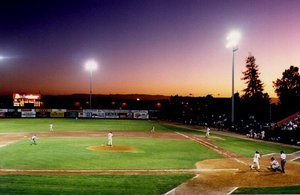Minor league baseball
|
|
- Part of the History of baseball series.
Minor leagues are baseball leagues which are at a lower pay level and generally play in smaller cities and towns than Major League Baseball. In North America, most but not all of the minor leagues are under the control of the two major leagues and are used for development of younger players. (Member organizations are known as "farm teams.") There are, however, "independent" leagues, whose teams are not affiliated with any major league team. In addition, there are also sandlot leagues.
The existence of the minor league system is partly due to major league baseball's ability to include a reserve clause in the contracts with minor league baseball players which gives a major league team exclusive rights to a player even after the contract has expired. This is possible in baseball because of a 1922 US Supreme Court decision which grants baseball a special immunity from antitrust laws.
The first league recognized as minor was the Northwestern League, which in 1883 entered into an agreement with the two major leagues at the time (the National League and the American Association), under which it would have a lower salary limit than the other two leagues. The National Association of Professional Baseball Leagues, now known as Minor League Baseball, was formed in Chicago on September 5, 1901 as a type of "minor league". Then the National Agreement of 1903 (http://roadsidephotos.sabr.org/baseball/1903NatAgree.htm), which made peace between the National League and the new American League, also further codified the notion of "minor league" and established classifications for different levels.
Even so, until about 1925, many minor league teams operated largely independently of any major league influence. Some teams in the higher minor leagues actually outdrew some major league teams and had players who made more money than some major leaguers. Many baseball writers of that time regarded the greatest of the minor league stars, such as Buzz Arlett, Jigger Statz, Ike Boone and Frank Shellenback, as equal to some major league stars.
It wasn't until after the 1925 season that the minor leagues began to be fully subordinated to the majors. Following that season, the majors and minors signed an agreement allowing any player on a minor league roster to be purchased for $5,000 from his minor league team. This power was leveled primarily at the Baltimore Orioles, then a Triple-A team that had dominated the minors for years with stars such as Babe Ruth and Lefty Grove because owner Jack Dunn refused to sell them to the majors for years.
Branch Rickey is credited with developing the first modern "farm system" in the 1920s. Under a farm system, major league teams own or have working relationships with minor league teams, and then stock those teams with prospects and reserve players, who can then be reassigned (to the major league team, or to another club in the farm system) at the discretion of the major league club. Today, every major league franchise has a farm system and only a few minor leagues operate independently of major-league influence.
Often affiliations between teams change for financial or competitive reasons. In 2002, for example, the AAA-level Rochester Red Wings terminated their 43-year-long affiliation with the major league Baltimore Orioles in part due to the declining quality of players recently selected by the Orioles' organization as compared to past decades.
Minor leagues associated with Major League Baseball are classified by level of play. Currently, the most experienced and skilled minor leaguers play in the 'AAA'-level ("Triple A") leagues, the International League and the Pacific Coast League. Major League players often move temporarily to AAA affiliates during a slump, to rehabilitate after an injury, or because a change in the major league team's lineup requires it to trim its roster. For this reason, AAA is often thought of as the Major 'minor league' and its teams are usually in the biggest cities in the U.S. and Canada not served by Major League Baseball.
Below the 'AAA'-level leagues are the 'AA'-level ("Double A") leagues, the Eastern League, the Southern League, and the Texas League. Most of the players in these leagues have moved up from the Single-A leagues, but some players drafted from colleges begin their minor-league careers in AA. Successful players can move from AA to AAA or sometimes directly to the major leagues.
There are more Single-A ('A') leagues, such as the Carolina League, which play a full season, as well as short-season single-A leagues and rookie ('R') development leagues.
Until the 1950s, there were also Class B, C, and D leagues (and, for half a season, one E league).
The Mexican League summer and winter leagues are classifed as AAA-level, as are Caribbean winter leagues.
List of leagues and teams
See: List of minor league baseball leagues and teams
External link
- Official website of leagues associated with Major League Baseball (http://www.minorleaguebaseball.com)

